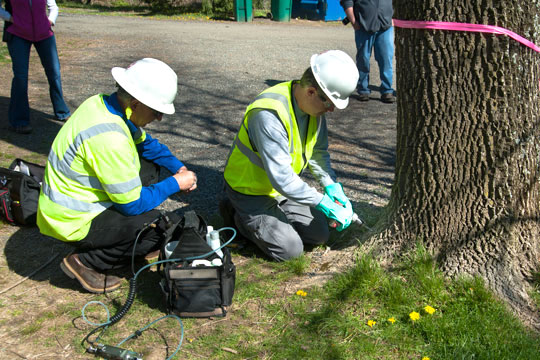Newlin Grist Mill in Concord Township is vaccinating trees on the property; some, anyway. About a dozen ash trees are being inoculated against the Emerald ash borer, a beetle-like pest that will kill the trees.
“They’re already in Chester County and, if they’re not here, they’re coming here,” said park Director Tony Shahan.
The Emerald ash borer — Agrilus planipennis — is a bright metallic green beetle that implants its eggs into ash trees. Over the course of a growing season, the implanted larvae eat through the host tree’s vascular system, ultimately destroying the tree.
“It’s been moving in from Western Pennsylvania for several years now,” Shahan said. “It’s almost here. We’ve been wringing our hands for several years, wondering what’s going to happen when it gets here. It’s in Chester County and will get here quickly.”
He said the borer has about a 90 percent kill rate. If enough trees are damaged or killed, Shahan said, that would leave the grounds open for more invasive plants, something he wants to avoid.
While there are hundreds of ash trees on the property, only 12 — those that are healthy and in areas that people visit most — are being inoculated, at least for now. Those areas are from the visitors’ center to the mill’s dam, and across the street at the mill site.
That’s phase one. Phase two would be to remove selected ash trees and replace them with other species.
The inoculations cost about $8 to $10 per inch of tree diameter. Asplundh Tree Service and Arborjet — a plant health solutions company — are donating their services to the Grist Mill and, according to Shahan, have agreed to donate those services for nine years.
Chemicals are being injected into the tree’s vascular system — the xylem and phloem — that carries water and nutrients up to the leaves and sugars and other metabolic products down from the leaves, according to Grist Mill Naturalist Jessica Shahan.
Those layers, she said, are very thin and lie just under the bark of the tree.
Officials at Newlin will evaluate the trees’ condition to see what else could or should be done.
About Rich Schwartzman
Rich Schwartzman has been reporting on events in the greater Chadds Ford area since September 2001 when he became the founding editor of The Chadds Ford Post. In April 2009 he became managing editor of ChaddsFordLive. He is also an award-winning photographer.



Comments